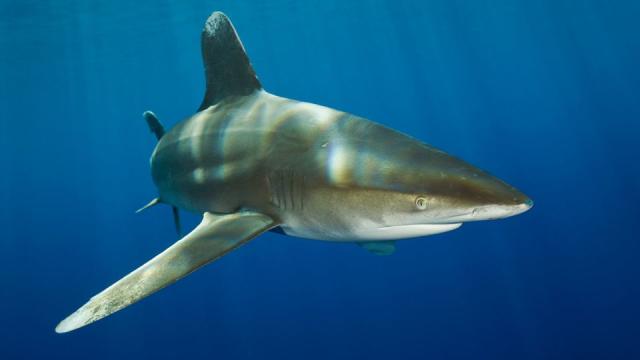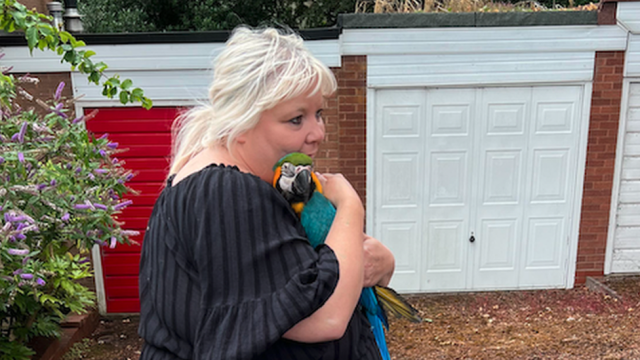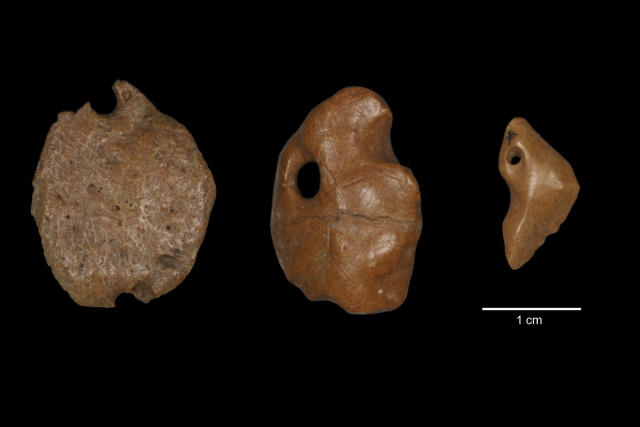Science Daily News | 12 Jul 2023

Views (76)

Pack of Wotsits used to rescue missing parrot
A snack-loving macaw flies away from its care home base after being spooked by a clap of thunder.

A care home's parrot that flew away when it was spooked in a storm has been reunited with its owner after being coaxed down from a tree with a pack of Wotsits.
Mango the macaw flew out of a window at the site in Great Barr, Sandwell, following a clap of thunder on Sunday.
The missing bird failed to respond to calls from worried Karen Godwin who said she was left distraught.
But Mango was eventually recovered with the help of a local tree surgeon.
Initially, though, the pushy pet refused to come quietly after being spotted on Tuesday about 50ft (15m) up a pine.
Rescuers then realised that along with climbing equipment, Wotsits were needed - the lunchbox staple to which the peckish parrot was partial.
Ms Godwin, the manager of the Newton Road facility from which Mango flew away, said she had been out through the night on Sunday to put up posters appealing for help.
Ms Godwin explained: "So all day Monday we were out there driving around, looking for her and I have to say the people of Great Barr and beyond have been absolutely amazing - they really came together to help look for her.
"I then got up [on Tuesday] and burst into tears thinking she was gone and 'it's been three days now and I just need to accept that'."
But the bird was located later in the day in a tree on nearby Danford Way.
Local bin men had stopped to help and tried to coax down the pet, Ms Godwin said, adding "the local fire brigade had been desperate to help but their ladders weren't high enough".
"In the meantime," she explained, "we had put it all on Facebook that we had found her again, and we had roofers and tree specialists and everyone contacting us offering help. And the amazing thing was it was such a beautiful ending."
Local tree surgeon Nathan McKane said he started getting alerts on social media on Tuesday morning asking whether he could assist using his specialist gear.
"It was only two streets away from me - I could see the tree from my house; I knew exactly which one it was," he said.
Mr McKane said when he arrived at the scene the parrot was sitting in the tree "squawking away".
"I was told it was quite friendly but when I got up there it didn't seem to want to come down nicely at all," he explained.
But using Wotsits, he eventually managed to get the bird close enough to reach.
"I managed to grab the back of its feathers and put it up against my t-shirt," Mr McKane said, "but I've been pecked to death. I've had to superglue my finger back together."
Ms Godwin told the BBC: "I can't even begin to thank Nathan enough or explain how I felt when he handed [Mango] across to me.
"When we walked in the door at the home with Mango earlier it was such a lovely surprise for all the staff and everybody - it's such a wonderful ending."
Blue Origin’s next-gen BE-4 rocket engine fails dramatically during testing in Texas
Jeff Bezos’ Blue Origin space venture confirmed that one of its BE-4 rocket engines suffered a significant anomaly during testing at its West Texas facility in late June. The incident first came to light today in a report from CNBC, which quoted unnamed sources as saying that the engine detonated about 10 seconds into a test firing on June 30. CNBC said the engine was meant to be used for the second launch of United Launch Alliance’s next-generation Vulcan rocket. That launch, known as Cert-2, i

The cause of last month’s anomaly is under investigation, Blue Origin said today in an emailed statement:
“In late June, we ran into an issue while testing Vulcan’s Flight Engine 3 at our West Texas facility. No personnel were injured, and we are currently assessing root cause. ULA was immediately made aware. The West Texas test facility is able to continue testing at the site. We already have proximate cause and are working on remedial actions. We will be able to meet our engine delivery commitments this year and stay ahead of our customer’s launch needs.”
Black men are at an increased risk for melanoma, study finds
Black men are at a higher risk of death from melanoma than other racial groups, according to a study published Tuesday in the Journal of the American Academy of Dermatology (JAAD).

Black men are at a higher risk of death from melanoma than other racial groups, according to a study published Tuesday in the Journal of the American Academy of Dermatology (JAAD).
Across 205,125 cases of male patients diagnosed with cutaneous invasive melanoma from 2004 to 2018 tracked by the National Cancer Database, the five-year survival rate was the lowest for Black men at 51.7%. The rate of survival was the highest for white men, at 75.1%, compared to the other racial groups in the study.
Cutaneous melanoma — a form of cancer that begins in pigment-producing cells — is the most aggressive and fatal form of skin cancer, according to the National Library of Medicine.
While gender and race are both predictors of survival in people diagnosed with cutaneous melanoma, less is known about the role race plays specifically among men; that is what the study explored.
Although it is not clear what factors contribute to an increased mortality risk for Black men with melanoma, the study found that Black men were less likely to have private insurance, and men more broadly were less likely to seek medical care than women, which can result in men being diagnosed at a later stage, according to Ashley Wysong, chair of the department of dermatology at the University of Nebraska Medical Center and a co-author of the study.
“Even after accounting for later stages at diagnosis, men still have worse overall survival rates than women with melanoma, so we suspect that there are some unmeasured social, genetic, tumor-specific and potentially biological factors at play, such as hormones and the way the immune system responds to melanoma tumors,” Wysong said.
Melanoma patients with darker skin often mistake their cancer for other skin conditions, which “can also delay care and definitive treatment,” she added.
Wysong recommends that people go to a board-certified dermatologist if they notice any lesions on the skin that are new, bleeding or not healing.
“We hope our research can lay the foundation for future studies to determine why there’s such a gap in survival rates, and to make headway to reduce these survival rate gaps,” she said.
Metal clouds turn scorching hot exoplanet into the universe's largest mirror
The CHEOPS exoplanet hunter has found a distant world so hot that it has clouds of metal making it the most reflective planet ever seen.

Astronomers have discovered the most reflective planet outside the solar system ever seen. The ultra-hot extrasolar planet, or exoplanet, acts like a cosmic mirror because it is covered by reflective clouds of metal.
Initially, the high reflectivity of LTT9779 b, a quality known as 'albedo,' was a mystery to scientists. This is because most planets, other than ice worlds or planets with reflective cloud layers like Venus, have low albedos as a result of their atmospheres or surfaces absorbing starlight, thus preventing it from being reflected back into space.
LTT9779 b was predicted to have a low albedo because, with a surface temperature of around 3,650 degrees Fahrenheit (2,000 degree Celsius) on the side of the exoplanet that permanently faces its star, it should be too hot to form clouds of water. This high temperature should make LTT9779 b too hot even for even clouds of metals or glass to form.
"It's a planet that shouldn't exist," says research co-author and Observatory of Côte d'Azur researcher Vivien Parmentier. "We expect planets like this to have their atmosphere blown away by their star, leaving behind bare rock."
The existence of such a planet prompted researchers to explore other theories for how these metal clouds formed. "It was really a puzzle until we realized we should think about this cloud formation in the same way as condensation forming in a bathroom after a hot shower," Parmentier added. "To steam up a bathroom, you can either cool the air until water vapor condenses, or you can keep the hot water running until clouds form because the air is so saturated with vapor that it simply can't hold anymore."
The team thinks that LTT9779 b got its metal clouds and its high albedo when its atmosphere was oversaturated with silicate and metal vaporized by scorching hot temperatures on the planet's permanent dayside.
The reflective nature of LTT9779b isn't its only extraordinary quality, however. The exoplanet is also an example of a planetary type that has eluded astronomers for decades and remains mysterious.
As an ultra-hot Neptune which orbits so close to its star, LTT9779b is the first in a population of "missing planets" to be discovered. Planets of this size and mass, which orbit close to their parent stars, have been long-absent from the exoplanet catalog, which now contains over 6,000 worlds.
This left an absence of planets with sizes and mass in between these categories at close proximities to their stars. An absence that has come to be known as the "hot-Neptunian desert" by scientists.
With a size just larger than its ice-giant namesake and a 19-hour orbit, LTT9779 b sits firmly in this gap.
RELATED STORIES:
The planet's survival in the hot-Neptunian desert so close to its star could share an explanation with its high reflectivity characteristic.
LTT9779 b is likely to be the focus of extensive study over the coming years, with the exoplanet representing a fine observational target for both the James Webb Space Telescope and the Hubble Space Telescope. This should allow scientists to better understand its atmosphere, clouds, and its other characteristics.
Pendants made from giant sloths suggest earlier arrival of people in the Americas
New research suggests humans lived in South America at the same time as now extinct giant sloths, bolstering evidence that people arrived in the Americas earlier than once thought. Dating of the ornaments and sediment at the Brazil site where they were found point to an age of 25,000 to 27,000 years ago, the researchers reported. “We now have good evidence — together with other sites from South and North America — that we have to rethink our ideas about the migration of humans to the Americas,” said Mirian Liza Alves Forancelli Pacheco, a study co-author and archaeologist at the Federal University of Sao Carlos in Brazil.

New research suggests humans lived in South America at the same time as now extinct giant sloths, bolstering evidence that people arrived in the Americas earlier than once thought.
Scientists analyzed triangular and teardrop-shaped pendants made of bony material from the sloths. They concluded that the carved and polished shapes and drilled holes were the work of deliberate craftsmanship.
“We now have good evidence — together with other sites from South and North America — that we have to rethink our ideas about the migration of humans to the Americas,” said Mirian Liza Alves Forancelli Pacheco, a study co-author and archaeologist at the Federal University of Sao Carlos in Brazil.
In the past decade, other research has challenged the conventional wisdom that people didn’t reach the Americas until a few thousand years before rising sea levels covered the Bering land bridge between Russia and Alaska, perhaps around 15,000 years ago.
The ornaments were discovered about 30 years ago at a rock shelter called Santa Elina in central Brazil. The new study is the first to analyze them extensively and rule out the possibility that humans had found and carved them thousands of years after the animals perished.
The team of researchers from Brazil, France and the United States said their analysis shows this handiwork was done within days to a few years after the animals had died, and before the materials had fossilized. The researchers also ruled out natural abrasion and other things that might explain the shapes and holes. They reported their findings Wednesday in Britain's Proceedings of the Royal Society B journal.
“We think they were personal objects, possibly for personal adornment,” said Thais Rabito Pansani, a co-author and paleontologist at the Federal University of Sao Carlos in Brazil.
Jennifer Raff, an anthropological geneticist at the University of Kansas, who was not involved in the study, said the new paper was “an important addition” to the conversation, but like any findings on the topic, it may also draw pushback.
Still, the evidence from multiple sites forces scientists to rethink old assumptions that people arrived only in one great wave of migration over the Bering land bridge, said Briana Pobiner, a co-author and paleoanthropologist at the Smithsonian Institution’s National Museum of Natural History in Washington.
Some may have died out, "but it's very likely that multiple waves of people came to Americas,” she said.
___
Follow Christina Larson on Twitter at @larsonchristina
___
The Associated Press Health and Science Department receives support from the Howard Hughes Medical Institute’s Science and Educational Media Group. The AP is solely responsible for all content.
Several shark species are facing extinction. Here’s how you can help
Older than dinosaurs and trees, sharks have endured a lot throughout their 450 million years on Earth. They’ve even survived five mass extinctions, including the asteroid that wiped out 75% of life on the planet. But many species of these aquatic apex predators are now in danger of dying out forever.

Research is key to conservation. Scientists rely on this information to inform wildlife and habitat management and conservation plans while advocates use data to develop and recommend policy to public officials. This research can also be used for public safety purposes as well as to educate future generations that will inherit the planet.
These research-oriented organizations are exploring the world’s reefs, seas, coastlines, and oceans to ultimately benefit shark conservation:
While the study found we may approach a “point of no return,” there are encouraging signs that conservation efforts are starting to work for white sharks and hammerheads thanks to government bans, policies, and quotas.
There is still a long way to go, however, so many conservation organizations like these are dedicated to rescuing and protecting these vulnerable creatures:
Organizations like the ones below are committed to protecting the health of the entire ocean and all life within it:
0 Likes
